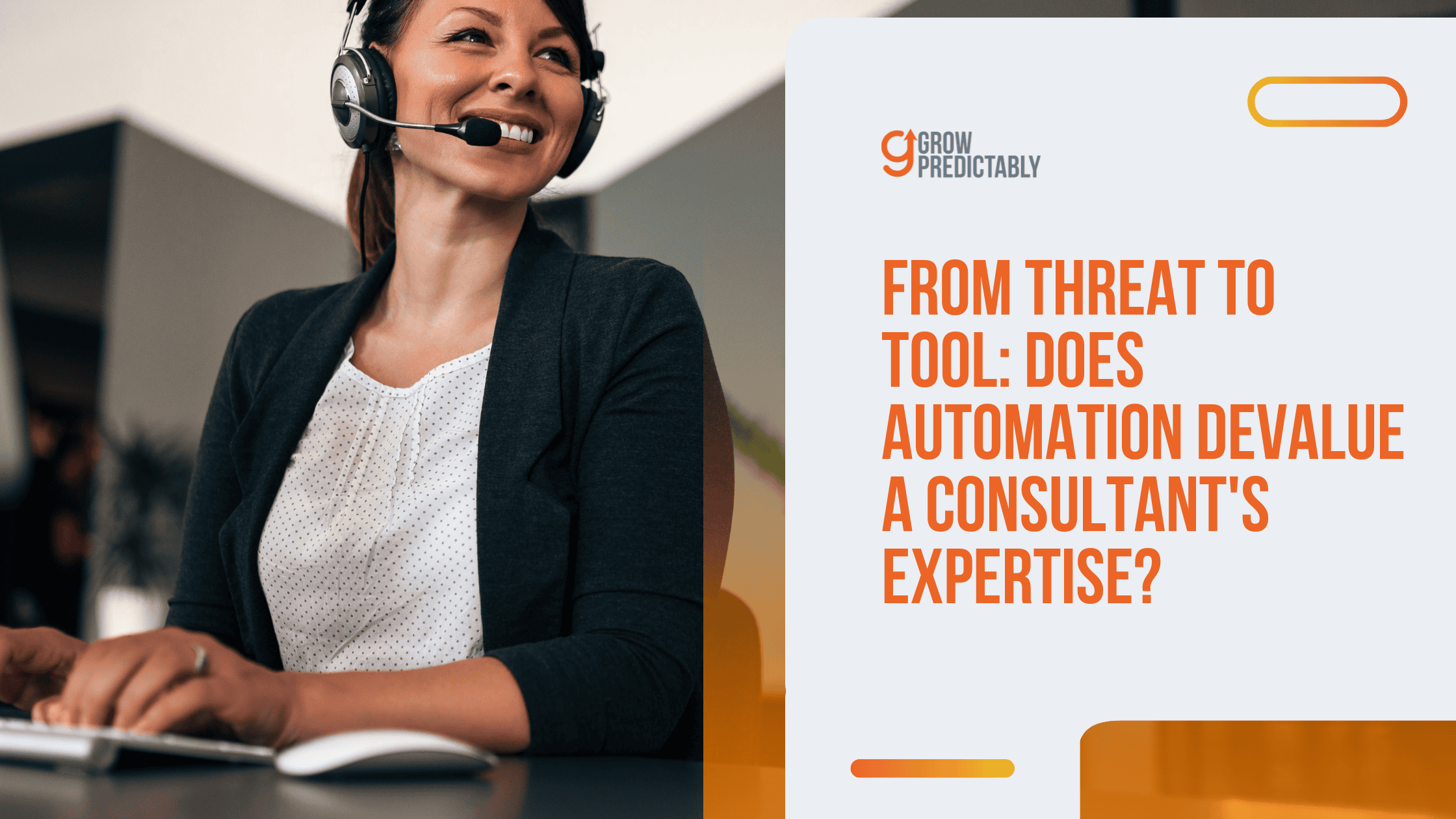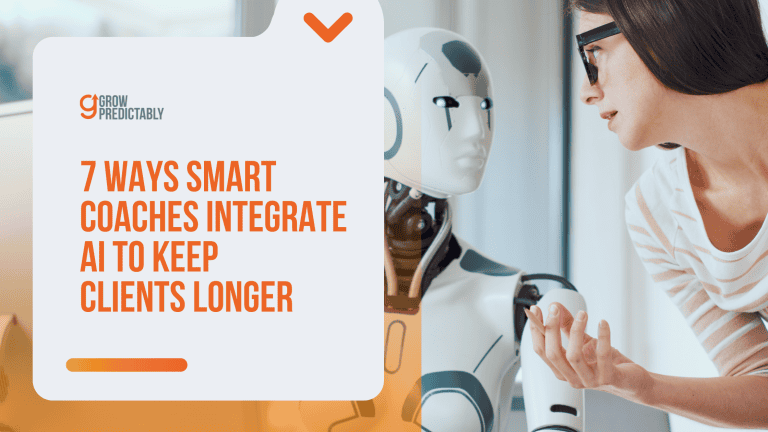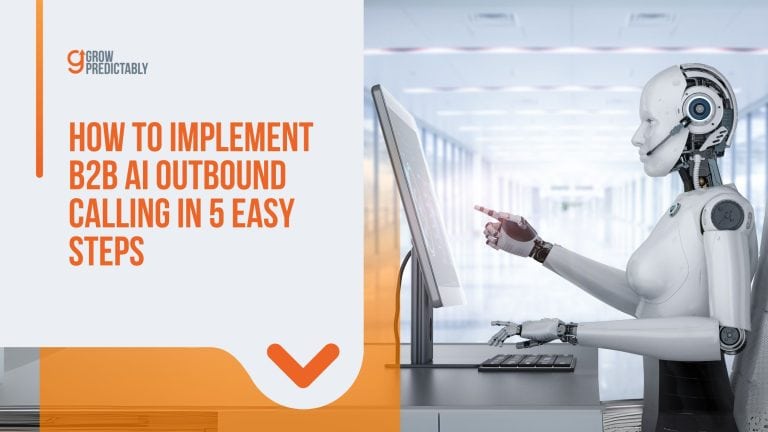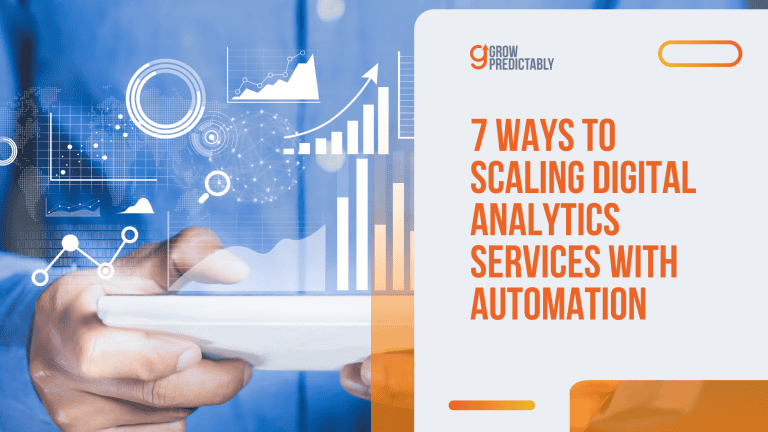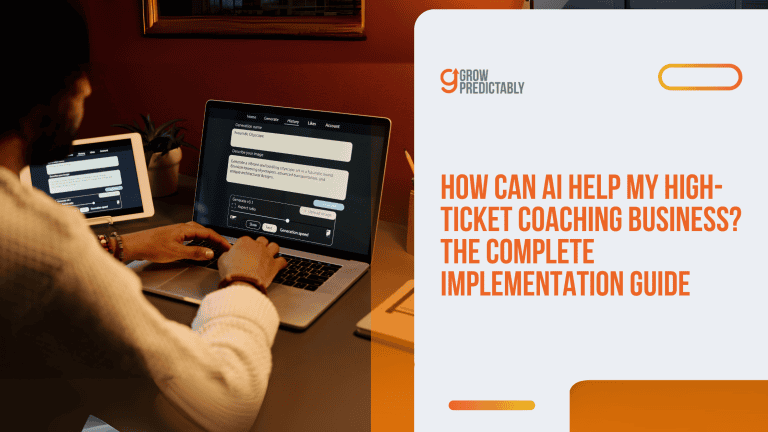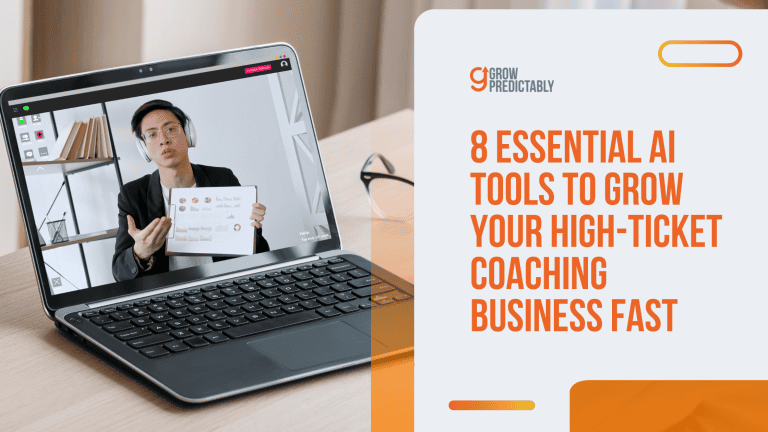From Threat to Tool: Does Automation Devalue A Consultant’s Expertise?
AI helps consultants complete tasks 25% faster and handle 12% more work—yet the question persists: does automation in consulting devalue a consultant’s expertise?
The fear is understandable: if technology handles the execution, what happens to your worth?
But that mindset misses where real value has shifted. Clients don’t pay for the hours you spend manually scheduling calls or drafting repetitive reports—they pay for the insights, strategy, and transformation you deliver.
Automation doesn’t diminish expertise; it amplifies your capacity to apply human judgment where it matters most.
Technology handles logistics; you handle outcomes.
At Grow Predictably, we’ve seen consultants reclaim 10+ hours weekly, double client capacity, and strengthen relationships precisely because automation handles what machines do best—leaving space for what only humans can deliver.
Here’s what that looks like.
TL;DR
Automation doesn’t devalue a consultant’s expertise; instead, it enhances efficiency by handling routine tasks. This allows consultants to focus on high-value, personalized client interactions, maintaining their unique expertise and transforming client experiences.
KEY TAKEAWAYS
- Map out your client journey to identify where automation can streamline processes without losing personalization.
- Choose user-friendly tools to automate routine tasks like appointment scheduling and follow-up messages.
- Regularly monitor and adjust your systems to ensure they complement your consulting by improving client communication and satisfaction.
Table of Contents
Understanding Automation’s Role in High-Ticket Consulting and Coaching
You’re about to see how top consultants and consulting firms in the consulting industry free up 10+ hours each week — without sacrificing service quality.
Ready to join them?
Automation in high-ticket coaching isn’t about replacing your expertise with generative AI tools, AI agents, or robots.
It’s about giving yourself breathing room to do what you do best: transform clients’ lives.
Let me paint a picture: Alex, a mindset coach, was drowning in admin work.
Client notes, follow-ups, scheduling—it all ate into his day.
Then he set up a Zapier workflow that automatically handled his client onboarding.
The result?
He doubled his client load while keeping those personal video check-ins that his clients loved.
What Is Automation in High-Ticket Services?
At its core, automation means using technology to handle repetitive tasks without manual effort.
For coaches and consultants in a consulting firm adapting their business model, this includes:
- Appointment scheduling and reminders
- Client onboarding sequences
- Follow-up messages
- Invoice generation and payment tracking
- Progress report creation
- Resource delivery
Think of automation as your behind-the-scenes team member who never sleeps, never complains, and handles the predictable stuff so you can focus on the transformational work for business development.
The “But Won’t It Feel Robotic?” Question
I hear this concern all the time.
Here’s the truth: automation doesn’t mean depersonalization—it means delivering a “human at scale.”
Take ActiveCampaign’s conditional workflows.
They can send tailored content based on a client’s specific challenges or goals.
When a client mentions “team conflict” in your intake form, they automatically receive your best resources on conflict resolution—before your first call.
This isn’t less personal; it’s more responsive and aligned with meeting client expectations.
Automation Enhances Each Step of the Customer Value Journey
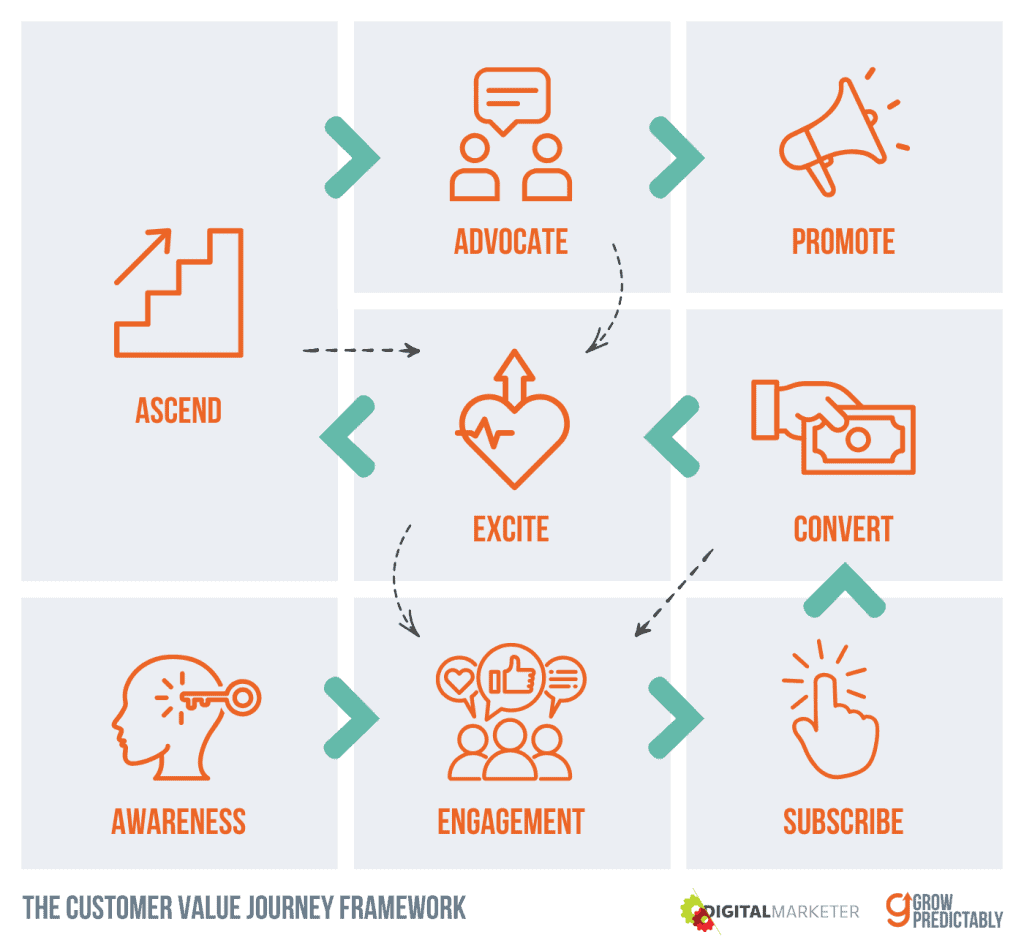
Let’s see how automation supports clients through each stage of their journey:
- Awareness: Automated social media posting ensures consistent visibility
- Engage: Chatbots qualify leads with basic questions before you invest time
- Subscribe: New email subscribers automatically receive welcome sequences
- Convert: Proposal acceptance triggers personalized onboarding flows
- Excite: Milestone-triggered messages celebrate client wins
- Ascend: Automated check-ins identify upsell opportunities
- Advocate: Testimonial requests sent at peak satisfaction moments
- Promote: Referral programs track and reward client recommendations
The magic happens when your client thinks, “Wow, they’re really on top of things!” — not knowing that automation handled the timing and delivery.
The Real Benefits for High-Ticket Providers
The numbers speak for themselves:
- Cut onboarding time by 50% (HubSpot, 2023)
- Reduce no-shows by 30% with smart reminder sequences
- Boost retention through perfectly-timed check-in messages
- Save 10+ hours weekly on administrative tasks
But beyond the metrics, automation creates space for deep work.
One coach told me: “I used to spend Fridays on admin, but now I use that time for relationship building and enhancing client connections.”
Now I use that day for strategic planning and my own professional development.”
The Human Touch Remains Essential
Remember Alex from earlier?
His secret wasn’t just automation—it was knowing when to automate and when to show up personally.
He automated the process but kept the relationship human.
His clients received automated reminders and worksheets, but they also got personal video messages before important sessions.
The automation handled the mechanics; Alex handled the magic.
Want to map your automation to every client touchpoint?
That’s where we go next.
The Measurable Impact
When coaches implement even basic automation, they typically see:
- 10+ hours saved weekly on administrative tasks
- 30% faster lead response times (crucial when hot prospects are shopping around)
- 2x higher conversion rates through consistent follow-up
- Reduced mental load from keeping track of every client interaction
From “Because of You” to “Running for You”
The real transformation happens when consultants or your consulting firm shifts from operating “because of you” (where everything stops if you stop) to “running for you” (where systems keep working even when you’re not).
This is how high-ticket consultants break through income ceilings – not by working more hours, or relying on traditional billing models, but by making each hour more valuable and focused on what only they can do.
But wait…won’t all this automation make your premium service feel robotic and impersonal?
That’s exactly what we’re covering next – how automation actually enhances the high-touch experience your clients expect, helping you manage and exceed client expectations.
How Automation Frees You to Focus on High-Value Work
Imagine if you could spend 80% of your time thinking, not doing.
Picture this: instead of drowning in scheduling emails, chasing invoices, or manually sending welcome packets, you’re crafting powerful new client frameworks.
You’re hosting transformative VIP intensives.
You’re building thought leadership content that positions you as the go-to expert in your field.
This isn’t fantasy—it’s what happens when you embrace automation in your coaching or consulting business, allowing for more flexible pricing models to accommodate different client needs.
Tasks You Can Automate Today
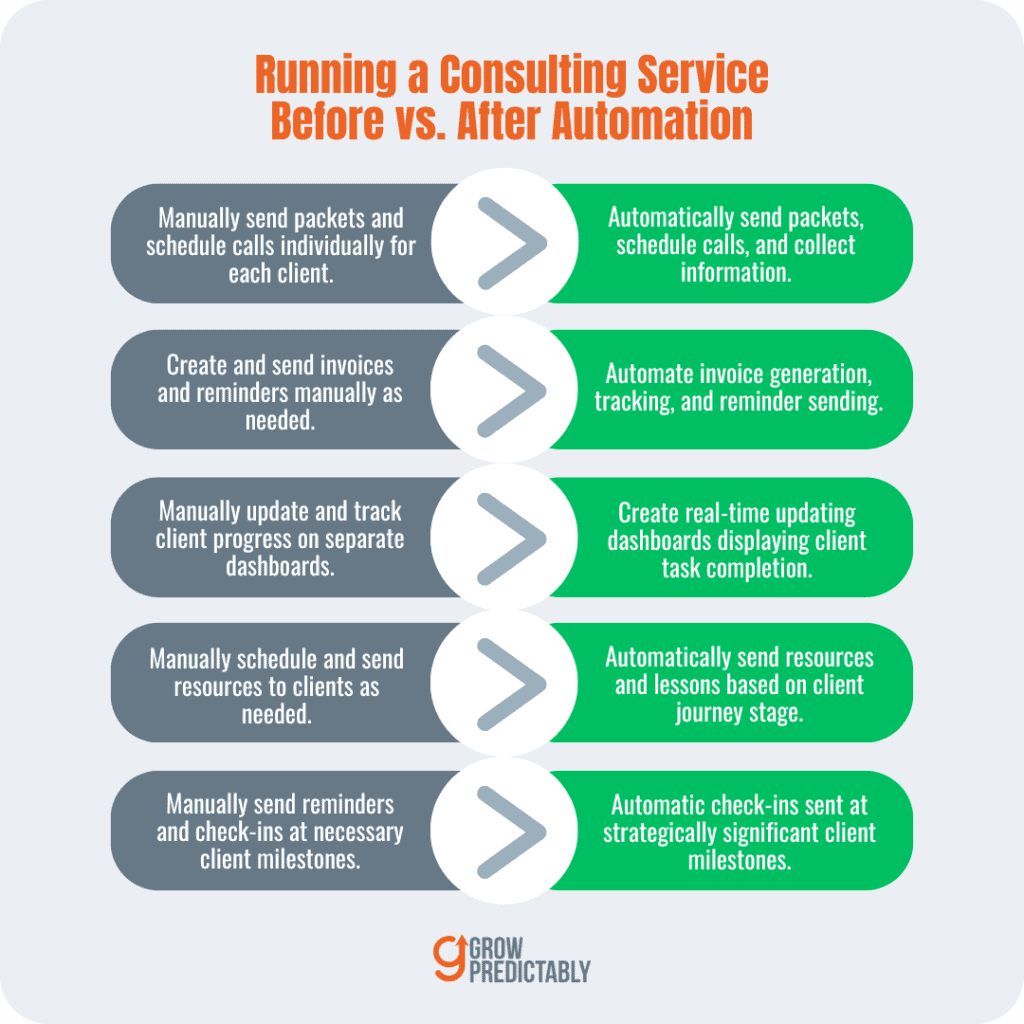
Tools like Zapier connect your favorite apps (think Trello and Gmail) without writing a single line of code, making life easier for consultants or any consulting firm, especially those dealing with complex client demands.
Here’s what you can hand off to your digital systems within your consulting service:
- Client onboarding: Send welcome packets, schedule kick-off calls, and collect initial information automatically when someone signs up.
- Payment processing: Generate and send invoices, track payments, and send gentle reminders for outstanding balances.
- Progress tracking: Create dashboards that update in real-time as clients complete tasks or reach milestones.
- Content delivery: Schedule and send resources, worksheets, or video lessons based on where clients are in their journey.
- Follow-up sequences: Send check-in messages at key moments without having to remember or manually trigger them.
Each of these automations delivers value faster and more consistently than manual processes ever could.
Moving Up the Value Pyramid
When you automate the execution layer of your business, you naturally shift up the Consultant Value Pyramid:
- From implementation to advisory: Less time spent on admin means more time guiding clients through transformative strategies.
- From reactive to proactive: Instead of constantly putting out fires, you can anticipate client needs and develop solutions before problems arise.
- From tactical to strategy consulting: Your mental bandwidth opens up for big-picture thinking that truly moves the needle for clients.
This shift doesn’t just benefit you—it dramatically increases the perceived value and the actual results you deliver to clients, positively influencing value based pricing for your services.
They’re not paying premium rates for your admin skills; they’re investing in your strategic insight and transformative guidance, similar to what they would seek from a management consultant, further enhancing their trust in your expertise.
The Real Freedom: Mental Space
Beyond the obvious time savings, automation creates something even more valuable: mental space.
When you’re not constantly switching between tasks, remembering to send follow-ups, or worrying about whether you’ve missed something, your brain can focus on what truly matters—helping your clients achieve breakthrough results.
This cognitive freedom is where the magic happens.
It’s where you develop innovative approaches, craft compelling content, and design experiences that transform lives.
Which 3 hours will you reclaim this week—and what high-impact task will you fill that time with instead?
Human Elements That Can’t Be Automated
What makes you irreplaceable?
It’s your:
- Intuition developed through thousands of client interactions
- Ability to ask the perfect question at the perfect moment
- Capacity to hold space for complex emotions
- Skill in adapting your approach on the fly when you sense resistance
No automation tool can duplicate these uniquely human capabilities.
When a client faces a crisis of confidence or needs to pivot their strategy, they’re not looking for an automated response—they’re seeking your wisdom and presence, enriched with real world examples that only you can provide.
The Ethics of Automation
With great automation comes great responsibility.
The AI Now Institute and OECD both stress the importance of transparency and accountability in automated systems.
What does this mean for you?
Be open with clients about how and where you use automation.
If AI helps draft your follow-up emails, let clients know.
Review all automated content for tone and relevance before it goes out.
Clients appreciate knowing there’s a real human overseeing the process, not just machines running on autopilot.
This transparency builds trust rather than diminishing it.
Your clients will value that you’re using technology to serve them better—not to create distance.
Finding Your Balance
The sweet spot in consulting isn’t choosing between being high-tech or high-touch—it’s finding the perfect balance.
Lean into automation for tasks; lean on yourself for trust, originality, and insight.
When you’re clear about what automation can and can’t do, you’ll make better decisions about where to invest your time and energy.
And you’ll feel confident knowing that while technology evolves, your strategic insight and human expertise remain your most valuable assets.
Case Study: How Experian is Redefining Leadership Development with AI

In an insightful case study, Experian, a global leader in data analytics and information services, showcases the transformational potential of their generative AI coach, Nadia.
This AI-driven initiative is spearheading a new wave of leadership development by providing real-time, personalized coaching to Experian’s 4,600 global leaders.
Challenge
Experian faced a common dilemma in large organizations: the need for scalable and timely leadership development without straining executives’ schedules.
While traditional live coaching was available, it couldn’t fully meet the demands for real-time and on-demand support, leaving a critical gap in their leadership and strategy consulting approach.
Solution
Enter Nadia, a groundbreaking AI-powered coach developed by Valence, designed to fill this gap.
Nadia interacts with leaders seamlessly through voice or text, diving into team dynamics, communication strategies, and other essential leadership topics.
Offering immediate feedback through role play and automated follow-ups, Nadia utilizes AI tools to tailor each session to align with Experian’s leadership models and values.
Results
The successful implementation of Nadia has resulted in remarkable engagement from Experian’s leaders, particularly in North America. Here are some key outcomes:
- 50% of global leaders engaging with Nadia do so on a regular basis.
- A whopping 90% return rate from initial users in North America, indicating strong satisfaction and utility.
- Leaders report enhanced preparedness for critical conversations and improved stakeholder influence.
Experian’s strategic adoption of generative AI is paving a new path for leadership development, demonstrating the power of generative AI and AI agents.
By integrating Nadia into their broader leadership ecosystem and aligning it with their business model, the company is ensuring that leaders at every level have access to vital resources and benefit from data analysis insights.
The ongoing enhancement of Nadia’s capabilities promises even more tailored experiences aligned with Experian’s organizational goals.
In embracing this innovative approach, Experian is setting a precedent for others seeking to democratize leadership development across global platforms.
Practical Steps to Integrate Automation Without Losing Your Unique Expertise
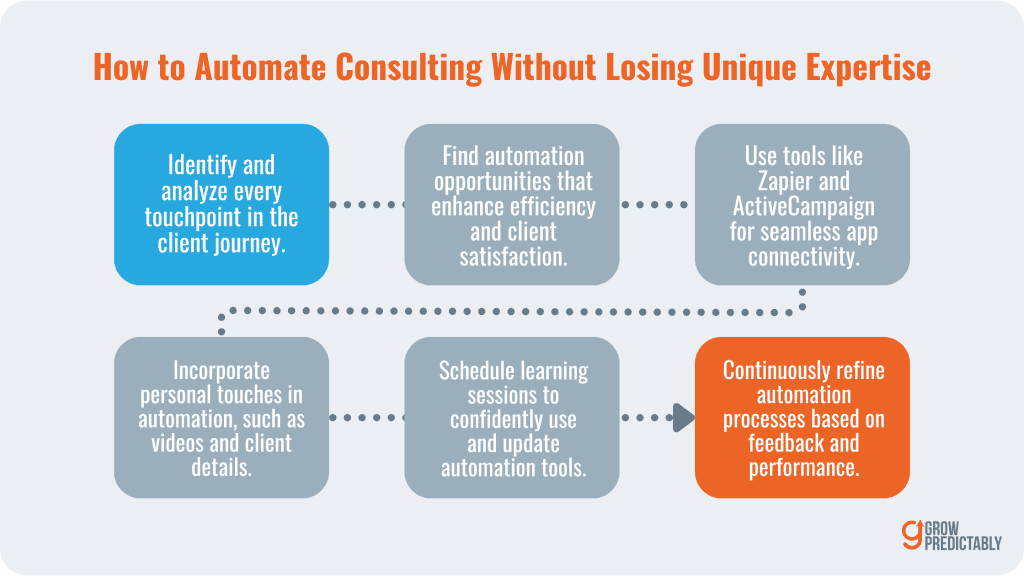
Are you ready to start working smarter instead of harder? Let’s get those systems working for you while keeping your special magic front and center!
Think of automation like having a super-organized assistant who handles all the repetitive stuff while you focus on what only YOU can do – transforming your clients’ lives. Here’s your step-by-step plan to make that happen:
1. Map Your Client Journey
First things first – you need to see the whole picture before you can improve it!
Grab a whiteboard or open up Miro and map out every single touchpoint in your client’s journey. Where are they getting stuck? Where are YOU getting stuck?
Look at each stage of the Customer Value Journey:
- Are potential clients finding you easily? (Awareness)
- Is responding to inquiries eating up your day? (Engage)
- How smooth is your booking process? (Subscribe)
- Are you manually sending the same welcome emails? (Convert)
One coach I know discovered she was spending 7+ hours weekly just handling scheduling back-and-forths – that’s almost a full workday!
2. Choose Strategic Automation Points
Now for the fun part – picking where automation will give you the biggest bang for your buck!
For example:
- At the Subscribe stage, set up Calendly for discovery calls (goodbye scheduling headaches!)
- During Convert, use ActiveCampaign to tag leads based on their needs and interests
- For Excite, create automated welcome sequences that deliver your intro materials
Think about it: what if your clients received a perfectly timed welcome email seconds after booking? No more “I’ll get to that later” delays that leave new clients wondering if they made the right choice.
3. Select User-Friendly Tools
You don’t need to be a tech wizard! These tools are designed for people like you:
- Zapier: Connects your apps together. When someone fills out your intake form → automatically send their personalized welcome packet
- ActiveCampaign: Handles email sequences and keeps track of your client relationships
- Loom: Record once, share forever! Create videos for your Excite stage that walk clients through your process
One quick win? Set up a Zap that automatically adds new clients to your CRM when they schedule their first call. No more copy-pasting contact info!
4. Maintain Personalization
This is where your expertise shines through! Automation doesn’t mean robotic:
- Use merge fields to include your client’s name, goals, or challenges
- Set up milestone triggers to celebrate client wins
- Record personal video messages at key Ascend stage check-ins
Remember: automation handles the process, but YOU provide the insight. When a client hits the 30-day mark in your program, an automated check-in with your personally recorded video feels both systematic AND special.
5. Train Yourself and Your Team
Set aside focused time to learn these new tools:
- Schedule weekly “system sprints” – even just 90 minutes can transform your workflow
- Use the help docs and tutorials that come with these tools
- Join user forums where you can ask questions
The key is connecting your training directly to your Customer Value Journey. For example, learn how to set up an automated sequence that encourages happy clients to become advocates through testimonials and referrals.
6. Monitor and Adjust
Your automation system isn’t “set it and forget it” – it’s “set it and perfect it”:
- Create simple tracking dashboards (Google Sheets + Data Studio work great)
- Check in with clients: “How’s our communication working for you?”
- Review metrics monthly: Are response times faster? Is client satisfaction higher?
One coach noticed that clients weren’t opening her day-7 check-in emails. After moving that touchpoint to text message instead, engagement jumped by 80%!
Ready to Start?
Which of these steps could you tackle tomorrow? Even automating one small part of your process can create ripple effects throughout your business.
Want to make this super easy? Download your “CVJ Automation Planner” template to map your flows and start reclaiming your time while delivering even better client experiences.
Remember – automation isn’t about removing yourself from the equation. It’s about removing the busywork so you can be even more present where it truly matters.
Your First Step Forward
Even if you’ve never opened Zapier or set up an automated sequence, you’re only one workflow away from a breakthrough.
The journey toward an automated practice doesn’t require a complete system overhaul — it starts with a single process.
What if you automated just one thing this week?
Maybe it’s your discovery call scheduling.
Or your welcome sequence.
Or your session reminders.
Pick one task that drains your energy, set up a simple automation, and watch what happens.
That small taste of freedom will fuel your next steps.
The future of the consulting industry belongs to those who can blend human wisdom with AI tools, technological efficiency, and consulting firm insights.
Your expertise remains irreplaceable — automation simply helps more people experience it.
Start your automation journey today, and unlock the future of your consulting practice.
Key Skills to Develop for Success Alongside Automation
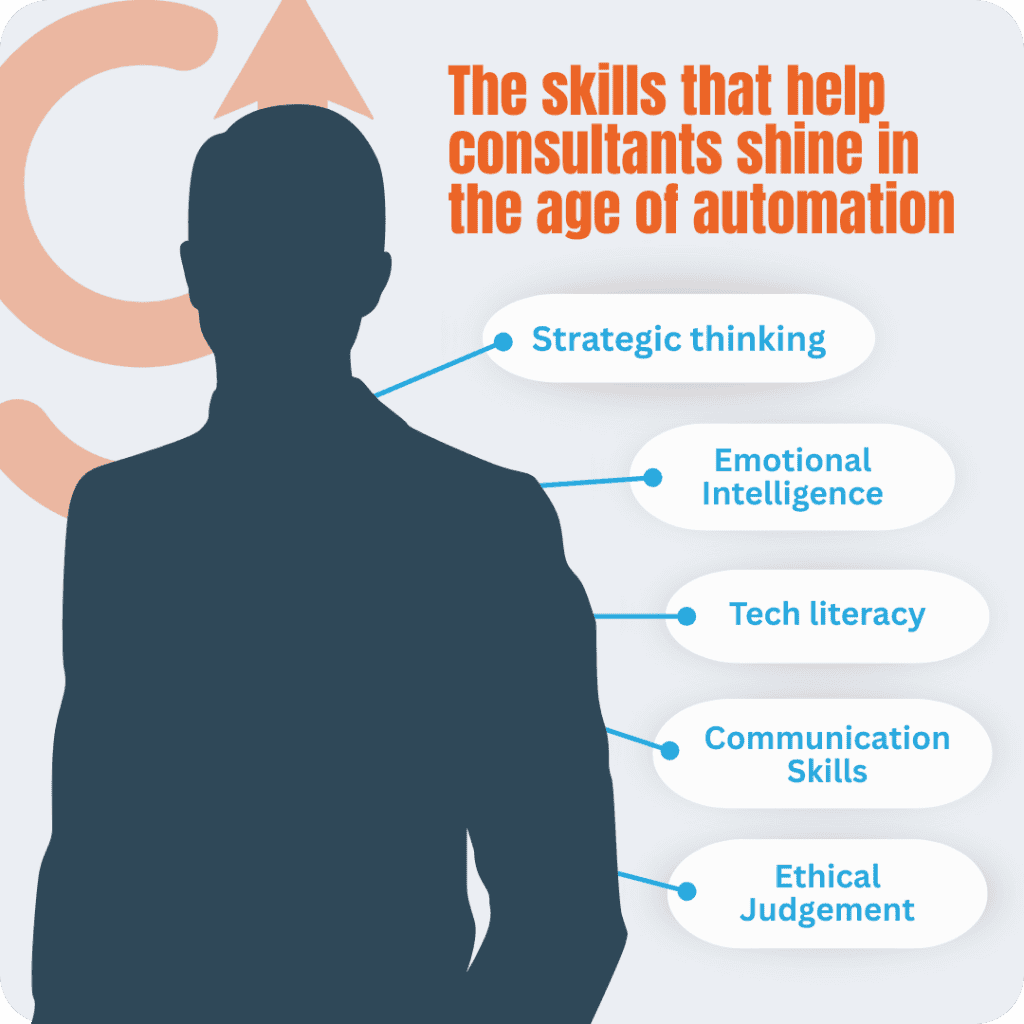
Ever wonder what makes some coaches thrive with automation while others struggle?
It’s not just about having the right tools—it’s about building the right skills to use them effectively!
Let me share what I’ve found works as the “secret arsenal” that unlocks automation’s full potential in your coaching business.
These five core skills will help you balance technology with your unique human touch:
1. Strategic Thinking + Creativity
This isn’t about knowing which buttons to push—it’s about designing workflows that actually deliver transformation.
When you map out your client journey, ask yourself: “How does this automation move my client closer to their goal?”
For example, if you’re a leadership coach, your automated check-in sequence isn’t just about staying in touch—it’s strategically timed to coincide with when clients typically face implementation challenges.
That’s thinking beyond the tool to the outcome!
2. Emotional Intelligence
The magic happens when you know exactly when to automate and when human connection is irreplaceable.
Think about this: When your client shares a major win in their feedback form, does an automated congratulations email feel right?
Or is this a moment that calls for a quick personal voice message?
Your ability to recognize these emotional touchpoints makes all the difference.
If your client gets a birthday SMS every year from you—automation made it happen, but your intent made it matter.
3. AI & Tech Literacy
You don’t need to become a programmer, but getting comfortable with platforms like Zapier, ActiveCampaign, and Notion will transform your business.
Start small!
Learn one automation at a time.
For example, master setting up a welcome sequence in ActiveCampaign before tackling more complex workflows.
The confidence builds with each small win.
4. Clear Communication
Your clients need to understand how your systems support their journey.
When you explain, “I’ve created this automated check-in system so nothing falls through the cracks in your progress,” you’re building trust in your processes.
The coaches who communicate the purpose behind their automation find clients appreciate the organization rather than feeling processed.
5. Ethical Judgment
As you automate more, you’ll need to monitor for unintended impacts.
Are all clients receiving equal attention?
Is your data being handled responsibly?
Make it a habit to review your automated systems monthly, asking: “Is this serving my clients fairly and effectively?”
This regular check keeps your automation aligned with your values.
Where to Build These Skills
You don’t have to figure this out alone!
Consider these learning environments:
- Peer-led workshops where fellow coaches and consulting firms in the consulting industry share their automation wins
- Finding a mentor who’s already mastered these systems
- Joining communities like “Automation for Coaches” where you can ask questions and see examples
One coach I know hosts monthly “system sprints” with peers where they each tackle one automation challenge together—learning happens so much faster in community!
Think of developing these skills as an investment that directly supports your revenue, aligns with value based pricing, upholds your integrity, and builds lasting client loyalty.
When you combine generative AI, AI agents, and powerful automation with these human capabilities, you create a coaching business model that scales without sacrificing what makes your work special.
What skill will you focus on developing first?
Even starting with just one area can create remarkable shifts in how effectively you serve your clients while reclaiming your time.
FAQs
⮞ Will this make me seem impersonal?
Not at all!
Think of automation as your way to scale genuine care without burning yourself out.
When you set up thoughtful, personalized touchpoints that trigger at just the right moment, you’re actually creating more consistency in how you show up for clients.
One coach I work with sends automated check-in messages before big client presentations – her clients feel more supported, not less.
The magic happens when you use automation to deliver the right message at the right time, freeing you to pour energy into those deep-dive strategy sessions where your presence truly matters.
⮞ Is this unethical or misleading?
Transparency wins every time.
There’s nothing unethical about using tools that help you deliver better service.
The key is honesty.
You don’t need to announce “THIS EMAIL IS AUTOMATED” in the subject line, but being straightforward about how you use technology to support your work builds trust.
For example, when sending automated follow-ups, keeping your natural voice and acknowledging that you’ve set up systems to stay connected shows both authenticity and professionalism.
⮞ I’m not technical — can I still do this?
Absolutely!
Today’s tools are built for people who break into a cold sweat at the word “coding.”
Tools like Zapier use simple “if this, then that” logic that anyone can grasp.
Drag, drop, connect—done!
There are templates everywhere to get you started, and most platforms offer step-by-step guides.
One coach started with just connecting her scheduling tool to her email platform, saving 3 hours weekly with zero tech background.
Start small, celebrate wins, and build from there!
⮞ Will it lessen my value?
Just the opposite!
Automation amplifies your ability to deliver your unique expertise where it counts most.
Think of automation like a personal assistant who handles the routine stuff so you can focus on the transformational work only you can do.
Your scheduler doesn’t diminish your coaching skills—it enhances your ability to use them.
One leadership consultant automated her pre-session prep materials and post-session summaries, which gave her back 5 hours weekly to develop new frameworks for her highest-paying clients.
Her value didn’t decrease—it multiplied.
⮞ Will clients trust it?
It’s all in how you frame it.
When you position your systems as reliability enhancers—”We use these workflows to make sure nothing falls through the cracks in your experience”—clients actually feel more confident in your professionalism.
High-paying clients aren’t impressed by manual hustle; they’re impressed by results.
They want to know you have solid systems backing your expertise.
In fact, many clients feel reassured seeing you invest in processes that ensure consistent delivery of what they’re paying premium prices for.
⮞ How do I know what to automate first?
Start with the repetitive tasks that drain your energy but don’t require your unique perspective.
Welcome emails, appointment reminders, resource delivery, and basic follow-ups are perfect starting points.
These are the tasks you’ve done so many times you could do them in your sleep—which means they’re prime candidates for automation.
One coach told me she wished she’d automated her onboarding process years earlier: “I spent so much time sending the same five emails when I could have been creating new offerings!”
Scale with Heart, Not Haste
To recap, integrating automation into your consulting or coaching practice is about scaling your care, not cutting corners.
Strategic automation empowers you to serve more clients without losing the bespoke experience your high-ticket clients expect.
It reduces errors, streamlines processes, and lets you consistently deliver delight across every stage of the customer journey.
You’ve worked too hard to spend your days on tasks technology can do. Imagine replacing stress with satisfaction and creating the space for your most impactful, creative work.
Will you commit to reclaiming your time and delivering elevated client experiences?
Dive deeper with resources from experts like Jay Abraham and the AI Now Institute to ensure both excellence and ethics.
What’s stopping you from automating just one part of your process this week? And how could more efficient systems help you become the go-to expert in your space?
Remember: The world needs your insight, not your inbox hustle. Persuade yourself to make the leap today—you’ll wonder why you waited so long.

